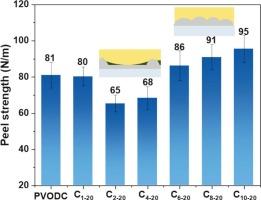纳米颗粒诱导粗糙度降低非有机硅涂层剥离强度
IF 7.3
2区 材料科学
Q1 CHEMISTRY, APPLIED
引用次数: 0
摘要
具有长烷基侧链的梳状聚乙烯醇十八烷基酯(PVODC)是一种很有前途的电子工业用非硅树脂脱模剂。尽管PVODC避免了由于不完全固化而导致的硅基脱模涂层可能出现的硅转移现象,但其剥离强度(81±7 N/m)对于许多应用来说仍然太高。本文制备了接枝异氰酸十八烷基酯(ODI)的疏水二氧化钛纳米粒子(TiO2 HNP粒子),并将其复合到PVODC涂层中,旨在评估其降低涂层剥离强度的能力。在HNP:PVODC = 2:20的最佳重量比下,涂层与胶带之间的剥离强度大幅降低至65±5 N/m。复合涂层的剥离强度是由小空腔形成导致的附着面积减少和HNP颗粒同时带来的附着面积增加/机械联锁效应之间的竞争决定的。因此,将HNP颗粒加入到脱模涂层中代表了一种简单的方法来调整脱模涂层的剥离强度。本文章由计算机程序翻译,如有差异,请以英文原文为准。

Reducing the peel strength of non-silicone organic release coatings by nanoparticle-induced roughness
Comb-like polyvinyl octadecyl carbamate (PVODC) with long alkyl side chains is a promising non-silicone release agent in the electronics industry. Although PVODC avoids the possible silicone transfer phenomenon of silicone-based release coatings caused by incomplete curing, their peel strength (81 ± 7 N/m) is still too high for many applications. Herein, hydrophobic titanium dioxide nanoparticles (TiO2 HNP particle) grafted with octadecyl isocyanate (ODI) were prepared and compounded into PVODC coatings, aiming to assess their ability to reduce the peel strength of coatings. At an optimal weight ratio of HNP:PVODC = 2:20, the peel strength between the coating and adhesive tape was found to reduce largely to 65 ± 5 N/m. It was suggested that the peel strength of composite coatings was determined by a competition between the reduction in the adhesion area due to the formation of small cavities and the increased adhesion area/mechanical interlocking effect brought simultaneously by HNP particles. Therefore, incorporating HNP particles into release coatings represents a facile route to tailoring the peel strength of release coatings.
求助全文
通过发布文献求助,成功后即可免费获取论文全文。
去求助
来源期刊

Progress in Organic Coatings
工程技术-材料科学:膜
CiteScore
11.40
自引率
15.20%
发文量
577
审稿时长
48 days
期刊介绍:
The aim of this international journal is to analyse and publicise the progress and current state of knowledge in the field of organic coatings and related materials. The Editors and the Editorial Board members will solicit both review and research papers from academic and industrial scientists who are actively engaged in research and development or, in the case of review papers, have extensive experience in the subject to be reviewed. Unsolicited manuscripts will be accepted if they meet the journal''s requirements. The journal publishes papers dealing with such subjects as:
• Chemical, physical and technological properties of organic coatings and related materials
• Problems and methods of preparation, manufacture and application of these materials
• Performance, testing and analysis.
 求助内容:
求助内容: 应助结果提醒方式:
应助结果提醒方式:


